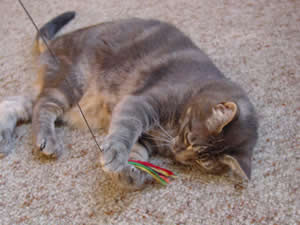An indoor cat cannot be hit by a car, be chewed by a dog, be poisoned by garden chemicals, or pick up a fatal viral disease from a stray cat. Despite these benefits, many people are hesitant to restrict their cats to an indoor environment. They worry that their feline friends are missing out on a natural lifestyle if they aren’t allowed to explore the outside world. They are also concerned that confinement will stimulate their cats to damage furniture or urinate in corners.
If you want to keep your cats inside, be assured that they can lead fulfilling lives and they won’t cause damage if you are willing to train and nurture them.
Cats need to scratch, but they don’t have to be destructive. Scratching is a natural healthy behaviour that cats do to shed their nail cuticles, strengthen their muscles and most importantly, to leave their scent on objects. Even declawed cats go through the motions of scratching to mark their territory.
 If you don’t want your cat to rake your new leather sofa or shred your curtains, you must train him to scratch somewhere else and reward him when he does it. A post wrapped with sisal is an attractive scratching surface that can stand up to repeated use. Cats like it because it’s soft enough to be shredded. Corrugated cardboard scratching posts and carpeted ones (especially those with the rough weave backing exposed) also work well.
If you don’t want your cat to rake your new leather sofa or shred your curtains, you must train him to scratch somewhere else and reward him when he does it. A post wrapped with sisal is an attractive scratching surface that can stand up to repeated use. Cats like it because it’s soft enough to be shredded. Corrugated cardboard scratching posts and carpeted ones (especially those with the rough weave backing exposed) also work well.
Watch your cat to see what style of post suits him. If he scratches on chair legs and up the sides of your couch, he probably would like a vertical scratching post. If he tends to scratch carpets, give him a horizontal surface to scratch. In both cases, make sure the structure is stable. If it falls over while he is scratching it, he is sure to avoid it.
Keep in mind that cats don’t only scratch for exercise, they also want to put their scent on things so that other cats (and humans) know they have been there. Your cat won’t be interested in a scratching post located in a dark corner of your basement. You are better off to place it in a busy area – near food and water bowls or close to litter boxes. If you have more than one cat, put several posts out where your cats congregate.
If your cat continues to destroy your couch even after the introduction of an attractive scratching surface, place the post right beside the spot he scratches. Then cover up the area on the couch he is shredding with something unattractive such as aluminum foil, double-sided sticky tape, sandpaper, or plastic carpet runner with the pointy side up. Alternatively, you can add an objectionable scent to the area by putting cotton balls soaked with citrus scent or perfume next to the object. Once your cat starts using his scratching post, slowly move it (no more than three inches per day) to where you want it to stay permanently.
An often overlooked, but very simple way to minimize the damage your cat does when he scratches, is to cut his nails regularly. You should do this about once a week, using a trimmer designed for cats. If you have never given your cat a pedicure, you need to do some training if you expect him to cooperate. First, get him accustomed to having his paws touched. When you hold his paw, offer him a treat and reward him with a pet. As he accepts your ministrations, press on a toe to mimic the pressure you’ll need to extend a claw for trimming.
Once your cat is content with your handling, you can start clipping his nails. Put your thumb on top of a digit and your index finger underneath and press down to extend his nail. When you can see the whole nail, look for the pink area called the “quick”. Cut off the razor-sharp tip below the quick. Don’t cut into the quick because it is filled with blood vessels and will bleed (besides being painful). At first, trim just one claw. Gradually increase the number of claws you cut until you can do an entire foot in one session. When this becomes routine, you will be able to trim all his nails at one time.
 Your cat’s ancestors often rested in trees. They enjoyed the view and were able to keep track of what was going on around them. Not surprisingly, most indoor cats also like perches. Manufactured perches come in a variety of shapes and sizes. Some are designed to be attached to windowsills. Others are put on top of a scratching post or form the top floor of a kitty condominium. Sometimes, your cat will choose his own place such as the top of the kitchen cupboards. If you are trying to get your cat interested in a perch, put some treats on it to encourage him to jump up and explore it. Pet and praise him whenever he goes to the perch. Never put him on it forcibly – he may interpret your behaviour as punishment so he will stay away from the area.
Your cat’s ancestors often rested in trees. They enjoyed the view and were able to keep track of what was going on around them. Not surprisingly, most indoor cats also like perches. Manufactured perches come in a variety of shapes and sizes. Some are designed to be attached to windowsills. Others are put on top of a scratching post or form the top floor of a kitty condominium. Sometimes, your cat will choose his own place such as the top of the kitchen cupboards. If you are trying to get your cat interested in a perch, put some treats on it to encourage him to jump up and explore it. Pet and praise him whenever he goes to the perch. Never put him on it forcibly – he may interpret your behaviour as punishment so he will stay away from the area.
Some cats prefer a quiet, comfortable place to sleep, hidden away from the flurry of activity in the house. Rather than a perch, they like to curl up under or on a bed or sofa. These places provide a safe haven.
If your cat is going to be an indoor cat, you need to provide a litter box. Many people don’t give litter boxes much thought until their cats stop using them. House soiling is a serious behavioural problem that can destroy cat-owner relationships.
The most common cause of house soiling is an inappropriate litter box. The box is not clean enough or not the right style. It may have the wrong litter or be situated in the wrong place.
Cats are fastidious animals so they avoid using a litter box that is dirty. They will seek out a cleaner place to urinate or defecate – often the carpet or the bed. Litter boxes should be scooped daily and washed weekly with mild dish detergent (soap that rinses off easily and does not leave a lingering scent).
Litter boxes come in many forms. Most cats prefer large, uncovered litter boxes because they can get in them and turn around easier. If your cat likes to scatter litter when digging the right hole, high sides can help confine the mess. If your cat is old (arthritic) or small, his box should have low sides. Covered litter boxes keep the litter out of sight but they also trap odours. If you want to use one of these boxes, you must keep it exceptionally clean.
Most cats prefer fine-grained unscented litters. Scoopable litters that clump have the advantage of being easy to clean, but some cats get the litter material stuck in the hair between the pads of their feet. Scented litters may be attractive for people, but they may repel some cats. If you keep the litter box clean, you won’t need deodorants to keep the area smelling fresh. Some people have good success with wood pellets for litter – this product is absorbent and can be composted in the garden. Once you find a litter your cat likes, don’t change it. If you want to try a new litter, give your cat a choice, one box with his regular litter and one with the new product.
Your cat needs privacy when toileting so his litter box should be in a quiet yet accessible location where pets and people can’t sneak up on him. You need to have at least one litter box per cat in your home. If you have a multi-level home, you should have a box on each floor because a convenient box will be a well used box.
 Indoor cats need to be entertained. It is your responsibility to provide your feline friend with stimulation and exercise – at least 1/2 hour of intensive activity every day. Your cat needs to stalk and pounce in the way of his ancestors that hunted not only for survival but also for fun.
Indoor cats need to be entertained. It is your responsibility to provide your feline friend with stimulation and exercise – at least 1/2 hour of intensive activity every day. Your cat needs to stalk and pounce in the way of his ancestors that hunted not only for survival but also for fun.
 You can satisfy your cat’s natural prey instincts by playing with him. Though toys come in many forms, your cat will have his preferences. He may like catching a feather dangling from the end of a stick, or he might like to toss a furry mouse in the air or run after a table tennis ball. If you want to entertain him on a budget, try a crumpled up ball of paper, the inside roll from toilet paper, or even an old cotton sock tied in a knot.
You can satisfy your cat’s natural prey instincts by playing with him. Though toys come in many forms, your cat will have his preferences. He may like catching a feather dangling from the end of a stick, or he might like to toss a furry mouse in the air or run after a table tennis ball. If you want to entertain him on a budget, try a crumpled up ball of paper, the inside roll from toilet paper, or even an old cotton sock tied in a knot.
Your indoor cat needs to express his natural behaviours, from scratching, to toileting, to chasing prey. With your help and understanding, he will learn to do all these activities in an appropriate manner. If you take the time to meet his needs, he will be happy and so will you.
Dr. Louise Janes D.V.M. & Dr. Jeff Grognet D.V.M
 Mid-Isle
Mid-Isle
Veterinary Hospital
5-161 Fern Road West
Qualicum Beach, BC
Tel (250) 752-8969
See all articles by Dr. Louise Janes D.V.M. & Dr. Jeff Grognet D.V.M.




When our cat got old (lived to be 21) she needed help with her nails, same as our last pooch. In both cases I was not comfortable clipping so I used 50 grit sandpaper, held their paw in such away that I could run the sandpaper back to front on one claw at a time. It worked beautifully.